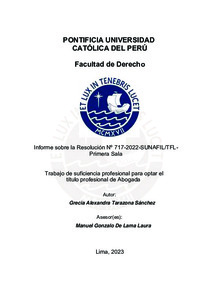Informe sobre la Resolución Nº 717-2022-SUNAFIL/TFLPrimera Sala
Abstract
El presente informe versa sobre el análisis efectuado por el Tribunal de Fiscalización
Laboral en la Resolución 717-2022-SUNAFIL/TFL-Primera Sala, para determinar si el
esquirolaje interno se encuentra, o no, dentro del alcance del supuesto que establece
el artículo 25.9 del Reglamento de la Ley General de Inspección del Trabajo, que
atribuye la comisión de una infracción muy grave cuando se configura la realización de
actos que vulneren el libre ejercicio del derecho a la huelga.
Al respecto, el Tribunal sostiene que no es posible subsumir al esquirolaje interno pues
no se encuentra enumerado de forma expresa dentro de los 3 supuestos
ejemplificativos que contiene la norma, razón por la que no puede ser sancionada sin
vulnerar, con ello, los principios de tipicidad y legalidad del derecho administrativo
sancionador. No nos encontramos de acuerdo con esta premisa, pues lo cierto es que
el Tribunal Constitucional ya ha establecido la validez de las cláusulas de interpretación
analógica, mientras que la Casación Previsional Nº 3480-2014 señala de forma expresa
que el esquirolaje interno sí se encuentra previsto en el artículo 25.9 del RLGIT.
En adición a ello, y más relevante aún, al tratarse de un derecho constitucional con
reconocimiento internacional, debió priorizarse la interpretación de la referida norma de
acuerdo con el ordenamiento jurídico nacional e internacional. El mismo que nos lleva
a concluir que el derecho a la huelga únicamente encontrará efectiva protección si todas
y cada una de las conductas que pretendan vulnerarla se encuentran sancionadas por
el artículo 25.9 del RLGIT. the present report treats about the analysis carried out by the Labor Inspection Court in
Resolution 717-2022-SUNAFIL/TFL-First Chamber, to determine whether or not internal
scabbing is within the scope of the assumption established in Article 25.9 of the
Regulations of the General Labor Inspection Law, which attributes the commission of a
very serious infraction when acts that violate the free exercise of the right to strike are
committed.
In this regard, the Court holds that it is not possible to subsume internal scabbing
because it is not expressly listed within the 3 exemplary cases contained in the
regulation, which is why it cannot be sanctioned without violating the principles of typicity
and legality of the administrative sanctioning law. We do not agree with this premise,
since the truth is that the Constitutional Court has already established the validity of the
analogical interpretation clauses, while Previsional Cassation No. 3480-2014 expressly
states that internal scabbing is indeed provided for in Article 25.9 of the RLGIT.
In addition to this, and even more relevant, since it is a constitutional right with
international recognition, the interpretation of the referred norm in accordance with the
national and international legal system should have been prioritized. This leads us to
conclude that the right to strike will only find effective protection if each and every one
of the conducts intended to violate it are sanctioned by article 25.9 of the RLGIT.
Temas
Derecho laboral--Jurisprudencia--Perú
Huelgas y paros--Perú
Inspección de trabajo--Perú
Sanciones administrativas--Jurisprudencia--Perú
Huelgas y paros--Perú
Inspección de trabajo--Perú
Sanciones administrativas--Jurisprudencia--Perú
Para optar el título de
Abogado





